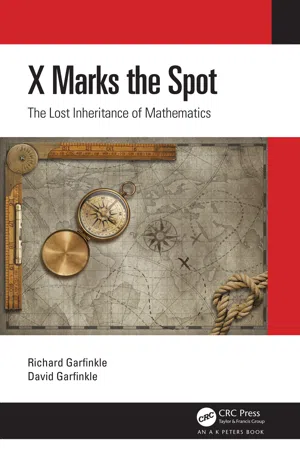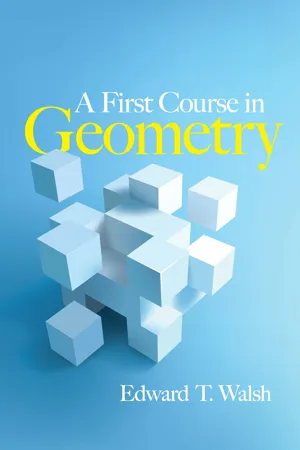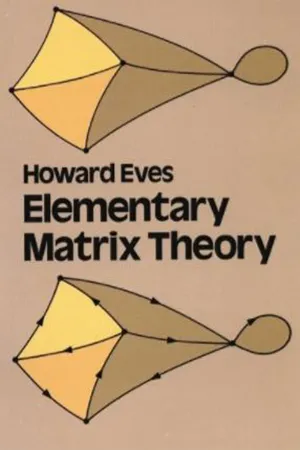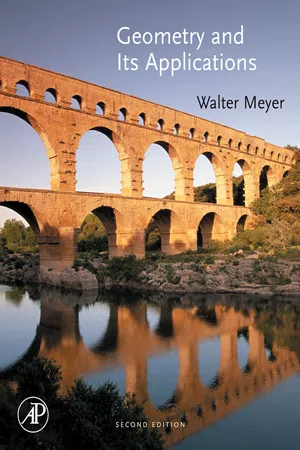Mathematics
Similarity
Similarity in mathematics refers to the comparison of two or more objects or shapes to determine how closely they resemble each other. It involves identifying proportional relationships and corresponding angles between geometric figures. Similarity is often used to solve problems involving scale, proportion, and congruence in various mathematical applications.
Written by Perlego with AI-assistance
Related key terms
Related key terms
1 of 4
Related key terms
1 of 3
8 Key excerpts on "Similarity"
- eBook - ePub
X Marks the Spot
The Lost Inheritance of Mathematics
- Richard Garfinkle, David Garfinkle(Authors)
- 2021(Publication Date)
- A K Peters/CRC Press(Publisher)
similar if one shape can be moved around and made uniformly bigger or smaller in order to cover the same set of points as the other.Intuitively, we can see that both congruence and Similarity are equivalence relations.For congruence :- Reflexivity : Each shape is certainly congruent to itself since we can move it a distance of 0 and lay it over itself.
- Symmetry : If we can move shape A onto shape B, we can move shape B onto shape A.
- Transitivity : If we can move shape A onto shape B and shape B onto shape C and then if we do the first motion followed by the second motion, we will have moved A onto C.
- For Similarity : It’s the same as the above except we also might be making the shape bigger or smaller.
With some work, we could prove this to algebraic satisfaction. Geometry, however, is a bit more practical in its laziness. There are some shapes that get used over and over again in geometry and a decent amount of time was spent creating proofs for when two shapes of these kinds are congruent or similar. Two circles are congruent if they have the same radius, since all you need to do is move one so that it has the same center as the other and behold the same set of points. Any two circles are similar, since if you put one at the same center as the other and then change its radius (which amounts to shrinking or enlarging it) to be equal to the other, you end up with the other circle.A number of tests were created to determine if two triangles were congruent. These always involved comparing the lengths of sides and the sizes of angles. These tests were formulated into rules put in a shorthand of “S” and “A.” For example, the SSS rule says that if two triangles have corresponding sides of equal length, they are congruent. The SAS rule says that if two triangles have two sides and the angle between them is equal, they are congruent. The ASA rule says that if they have two angles and the side between them is equal, they are congruent. - eBook - ePub
- Edward T Walsh(Author)
- 2014(Publication Date)
- Dover Publications(Publisher)
Geometry will draw the soul toward truth.PLATOCHAPTER SIX
Similarity
6.1 INTRODUCTION
In the sixth century B.C ., the illustrious mathematician Pythagoras founded a school which adopted the philosophical premise that the examination of everything in nature, geometric forms included, would yield properties that could be expressed in terms of whole numbers. According to legend, the Pythagoreans were onboard ship when one of them demonstrated to the others that, no matter what unit of measure was employed, it was impossible to express the lengths of the legs and hypotenuse of an isosceles right triangle as whole numbers. Since this fact violated Pythagorean doctrine, it was viewed as a serious threat by the Pythagoreans, who responded by throwing its heretical author overboard–or so the story goes.Thus was generated a “crisis” in mathematics which lasted for nearly two hundred years, until Eudoxus invented his elegant and ingenious theory of ratio and proportion. Eudoxus’ work is generally believed to have furnished the entire content of Book V of Euclid’s Elements.In previous chapters, we examined the congruence relation between geometric sets of points. Specifically, we defined congruence for segments, angles, and triangles. When we say that two such figures are congruent, we are saying that they are the same shape and the same size.In this chapter we will begin to consider relations between figures that are the same shape but not necessarily the same size. We have a name for such figures: We say they are similar.Eudoxus’ theory of proportion provides the tools we will use to explore and refine the Similarity relation. The notion of Similarity will then lead us to a proof of what is known as the Pythagorean Theorem - eBook - ePub
- Howard Eves(Author)
- 2012(Publication Date)
- Dover Publications(Publisher)
5. Similarity AND CONGRUENCE5.1. Similar matrices. Problems. 5.2. Similar matrices (continued). Problems. 5.3. Congruent matrices. Problems. 5.4. Canonical forms under congruency for skew-symmetricmatrices. Problems. 5.5. Canonical forms under congruency for symmetric matrices. Problems. 5.6. Conjunctivity, or Hermitian congruence. Problems. 5.7. Orthogonal matrices and orthogonal Similarity. Problems. 5.8. Unitary matrices and unitary Similarity. Problems. 5.9. Normal matrices. Problems. ADDENDA. 5.1A. Companion matrices. 5.2A. Regular symmetric matrices. 5.3A. Rotations in 3-space. 5.4A. Cayley’s construction of real orthogonal matrices. 5.5A. The characteristic roots of an orthogonal matrix. 5.6A. Definite, semidefinite, and indefinite real svmmetric matrices. 5.7A. Gram matrices. 5.8A. Some theorems of Autonne. 5.9A. Simultaneous reduction of a pair of quadratic forms. 5.10A. Hadamard matrices.5.1 Similar matrices
In Chapter 2 we considered the important notion of equivalence of matrices. Two m × n matrices A and B, it will be recalled, are equivalent if and only if there exist nonsingular matrices P(n )and Q(m )such that B = QAP. In the present chapter we shall concern ourselves with certain special types of equivalence of matrices, obtained by further restricting the two matrices P and Q in the relation B = QAP. These restricted equivalences find extensive application in various parts of science and mathematics, and just as the notion of general equivalence arises naturally in the consideration of systems of linear equations, the restricted equivalences can be shown to arise naturally in the consideration of some one or other of the applications. It is not our aim, however, to approach the restricted equivalences via applications of them.In this first section of Chapter 5 we briefly examine the special equivalence of matrices known as Similarity, a concept that arises naturally in the study of linear transformations.5.1.1 DEFINITION AND NOTATION. Square matrix B is said to be similar to square matrix A, and we write B A, if and only if there exists a nonsingular matrix P such that B = P -1 AP. - Nord-Eddine Sad Chemloul(Author)
- 2020(Publication Date)
- Wiley-ISTE(Publisher)
3 Similarity of Flows3.1. Definition and principle of Similarity
Similarity allows us to determine whether two flows are comparable, and if they are, to determine the relationships that make it possible to transpose the numerical results from one to the other.3.1.1. Geometric SimilarityIf L1 and L2 are the reference lengths representing homologous dimensions of the two domains, then their relationship:[3.1]is the geometric scale ratio (or length scale ratio) between the prototype (1) and the model (2).For two homologous points M1 and M2 , the ratios relative to each of the coordinates are equal to AL :[3.2]Similarity of two flows. For a color version of this figure, see www.iste.co.uk/sadchemloul/mechanics.zipFigure 3.1.NOTE 3.1.– It is impossible to obtain a complete geometric Similarity, because it is not possible to create a model that perfectly represents the state of the surface for the walls of a structure.
This Similarity concerns the streamlines and the trajectories, and consequently, the velocity field.3.1.2. Kinematic SimilarityTwo flows are kinematically similar when, regardless of the hom ologous point pairs (M1 and M2 )1 considered, the relationship- eBook - ePub
- Walter Meyer(Author)
- 2022(Publication Date)
- Chapman and Hall/CRC(Publisher)
7 Transformation Geometry III: Similarity, Inversion and ProjectionsDOI: 10.1201/9780429198328-7Until now, we have studied isometries extensively, but they are not the only geometric transformations which are theoretically interesting and useful. In this chapter, we introduce other types of transformations and their applications in computer graphics, cartography, the theory of mechanical linkages, and computer vision.Prerequisites: Sections 1 and 2 rely on some facts about similar triangles (material covered in Section 4 of Chapter 2 ).In Section 1 , the composition of transformations (covered in Section 2 of Chapter 4 ) comes up but can be avoided. In any case, only the definition is needed.In Sections 3 , 4 , 5 , we undertake our most extensive study of three-dimensional geometry, using vector equations of lines and planes (covered in Sections 1 and 2 of Chapter 5 ), as well as the axioms pertaining to three dimensions (Section 3 in Chapter 1 ).Section 1. Central Similarity and Other Similarity Transformations
We are surrounded by pictures which are not life-size: huge faces on billboards, tiny ones on our drivers' licenses, etc. The process of getting an image blown up or squeezed down can be thought of in terms of the geometric transformation called central Similarity.Definition: Let C be any fixed point in the plane and r any positive number. The transformation called1 central Similarity SC,ris defined as follows:- The image of C is C itself.
- For any point other point P, the image P'—also denoted SC,r(P)—is the point with the following two properties:
- CP' = r CP.
- P and P' are on the same side of C on the line .C P↔
The point C is called the centre of the transformation and r is called the ratio of Similarity.It is also possible to define central Similarity for a negative value of r: First, take the absolute value of r and proceed as above. Finally, apply rotation of 180° to the resulting point. Figure 7.1 shows central similarities with r = 2 and −2. Unless we say otherwise, we deal exclusively with central similarities with r - eBook - ePub
Talking about God
The Concept of Analogy and the Problem of Religious Language
- Roger M. White(Author)
- 2021(Publication Date)
- Routledge(Publisher)
The starting point for explaining the particular kind of model that can be defined using analogy is Euclid Book VI. It is here that we find the raw materials for defining the simplest of all such models—the scale model.Euclid VI, Definition 1: Similar rectilinear figures are those which have their several angles equal, each to each, and the sides about the equal angles proportionals.Book VI is principally concerned with the properties of similar figures, of which the simplest examples are similar triangles. As said in this first definition, it is the idea of proportionality, or analogy, that explains the relevant notion of Similarity. Suppose we have two triangles, ABC and A’B’C’, such that pairs of corresponding sides are analogous to one another (AB/A’B’ = BC/B’C’ = AC/A’C’), then the triangles are called similar.17 This in fact gives us the simplest kind of scale model: one triangle may in this case be considered as a scale model of the other.The idea of one triangle being similar to another can readily be extended to the case of an arbitrary rectilinear figure being similar to another, and in Proposition 18 of Book VI Euclid gives the simple construction necessary if you wish to construct a rectilinear figure that is a model of a given one: you only need to ensure that every triangle in the original figure is similar to the corresponding triangle in the model. This suffices to give us the general notion of a scale model: a scale model of a given figure (rectilinear or otherwise) is a second figure in which every triangle inscribed in the model is similar to the corresponding triangle in the original figure.Although if we wish to understand the notion of an analogical model in general we shall need to consider far more complex and subtle cases than the simple case of the scale model,18 it is worth pausing to consider this case, since we arrive at the general notion by extending ideas that are already present in the idea of the scale model. One of the main concerns of Book VI is to decide which geometrical properties will be held in common by the two similar figures: thus, to give simple examples, we can prove that corresponding angles will be equal,19 - eBook - ePub
- Clayton W. Dodge(Author)
- 2012(Publication Date)
- Dover Publications(Publisher)
similitude is also used for this mapping.This section completes our study of similarities and their properties, so that we may proceed rapidly to the applications in Sections 27 to 29 . Although the theory we develop here is not as extensive as that for isometries in Chapter 2 , it is quite sufficient for our purposes.26.2 Theorem A Similarity of ratio 1 is an isometry.26.3 Theorem A Similarity maps segments into segments.Let a Similarity of ratio k map A to A′ and B to B′. Take any point P between A and B and let the image of P be P′. Thenso P′ lies on segment A′B′.26.4 Theorem A Similarity is a transformation of the plane.26.5 Theorem A Similarity preserves angles.Mark points B and C on the two sides of angle A to form a triangle ABC. Let the Similarity map triangle ABC to triangle A′B′C′ by Theorem 26.3 . ThenThus triangles ABC and A′B′C′ are similar by SSS. Hence and the theorem follows.26.6 Corollary A Similarity maps a triangle into a similar triangle. More generally, it maps a polygon into a similar polygon.26.7 Theorem A Similarity is determined by any three noncollinear points and their images.26.8 Theorem There are exactly two similarities, one direct and one opposite, that map any point pair A, B into any other point pair A′, B′ (understanding that A ≠ B, A′ ≠ B, A′ is the image of A, and B′ is the image of B).26.9 Theorem Each direct Similarity of ratio k that is not an isometry is the product of a rotation and a homothety of ratio k having the same center. Furthermore, such a product is commutative.Clearly such a product is a direct Similarity. By Theorem 26.8 , this Similarity is determined by a segment AB and its image A′B′. Let AA′ and BB′ meet at Q, and draw the circles through A, B, Q, and through A′, B′, Q to meet again at O, as shown in Fig. 26.9 . Then we haveandby the properties of angles inscribed in a circle. Hence triangles ABO and A′B′O are similar. Now, if AB is rotated about O through angle AOA′ to A1 B1 then A1 B1 is parallel to A′B′ and triangles OA1 B1 and O, A′B′ are similar, so B1 lies on line OB′. Thus the homothety H(O, k) maps A1 Bl to A′B′. This rotation and homothety satisfy the theorem. Now, if the figure formed by O, A1 , B1 , A′, B′ is rotated about O through angle A - eBook - ePub
- Walter A. Meyer(Author)
- 2006(Publication Date)
- Academic Press(Publisher)
Chapter 7 Transformation Geometry III: Similarity, Inversion, and ProjectionPrerequisites: Sections 7.1 and 7.2 rely on some facts about similar triangles (material covered in Section 2.4 ). In Section 7.1 , composition of transformations (covered in Section 4.2 ) comes up but can be avoided. In any case, only the definition is needed. In Sections 7.3 , 7.4 , and 7.5 we undertakeour most extensive study of three-dimensional geometry, using vector equations of lines and planes (covered in Sections 5.1 and 5.2 ) as well as the axioms pertaining to three dimensions (Section 1.3 ).Up to this point, we have studied isometries extensively. But isometries are not the only geometric transformations that are theoretically interesting and practically useful. In this chapter we introduce some other types of transformations and their applications in computer graphics, cartography, the theory of mechanical linkages, and computer vision.7.1 Central Similarity and Other Similarity Transformations in the Plane
We are surrounded by pictures that are not life size: huge faces on billboards, tiny ones on our drivers’; licenses, etc. The process by which an image gets blown up or squeezed down can be thought of in terms of the geometric transformation called central Similarity.DEFINITION
Let C be any fixed point in the plane and r any positive number. The transformation called1central Similarity SC,ris defined as follows:(a) The image of C is C itself.(b) For any other point P , the image P ′ — also denotedSC,r(P ) — is the point with the following two properties:1. CP ′ = r CP.2. P and P′ are on the same side of C on the line .The point C is called the center of the transformation, and r is called the ratio of Similarity.It is also possible to define central Similarity for a negative value of r : First take the absolute value of r and proceed as before. Finally, apply rotation through 180° to the resulting point. Figure 7.1 shows central similarities with r = 2 and −2. Unless we say otherwise, we deal exclusively with central similarities with r
Index pages curate the most relevant extracts from our library of academic textbooks. They’ve been created using an in-house natural language model (NLM), each adding context and meaning to key research topics.
Explore more topic indexes
Explore more topic indexes
1 of 6
Explore more topic indexes
1 of 4







